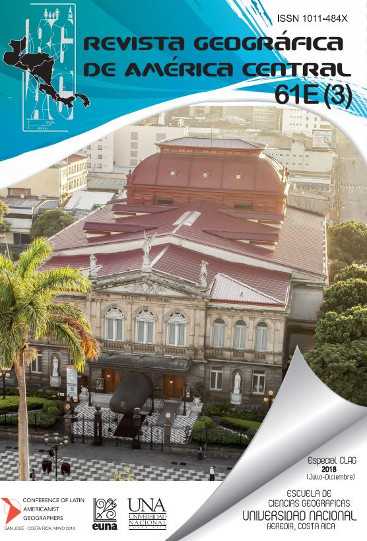Historic territorial estructuring road. The case of the route of the Cíbola, in the colonial period
DOI:
https://doi.org/10.15359/rgac.61-3.23Keywords:
territorial estructuration, New Spain, roads, frontier, Septentrion.Abstract
The Route of the Cibola arose from a series of expeditions undertaken beginning in the 16th Century – taking advantage of old roads and prehispanic trails – that allowed the incursion and expansion into the northwestern region of New Spain. The route was studied by, inter alia, Carl Sauer, who brought it international recognition. Our purpose here is to analyze this route cartographically and examine its territorial implications, which entails analysis of the geographical changes provoked concomitantly with the advance of the Colonial boundary. Th complementary, it analyzes the geographical changes that they provoked with de Colonial boundary advance. Notably, the old roads of the path was one of the factors facilitating the territorial expansion of New Mexico in the Mexican Northwest. For this study, we utilize primary document sources and process them through geographic information systems with a historical orientation (H-GIS).
References
Calderón, J. A. (ed.). (1984). Cartografía histórica de la Nueva Galicia, Guadalajara, Universidad de Guadalajara/Escuela de Estudios Hispano-Americanos.
Cramaussel, C. (2006). “Introducción”, en C. Cramaussel (coord.), Rutas de la Nueva España, Zamora, El Colegio de Michoacán, pp. 17-23.
Cué, M. E. (1994). “El mito de las siete ciudades”, Anales de Antropología (31), pp. 167-211.
Del Bosque, I., C. Fernández, L. Martín-Forero, E. Pérez (2012). Los sistemas de información geográfica y la investigación en ciencias sociales y humanas. Madrid, Confederación Española de Centros de Estudios Locales (CSIC).
Guzmán, C. (2017). “Investigación histórica, los SIG y las nuevas posibilidades metodológicas y epistemológicas”, en P.S. Urquijo, A. Vieyra y G. Bocco (coords.), Geografía e Historia Ambiental. Morelia, Centro de Investigaciones en Geografía Ambiental, UNAM, pp.193-214.
Lefebvre, K. (2017). “Colonialismo y paisaje, ¿cómo explotar los datos históricos para reconstruir el territorio colonial?, en P. S. Urquijo, A. Vieyra y G. Bocco (coords.), Geografía e Historia Ambiental, México, Centro de Investigaciones en Geografía Ambiental, UNAM, pp. 215-242.
Mendoza, H. (2000). Los mapas y el siglo XX mexicano, en H. Mendoza (coord.), México a través de los mapas, México, Instituto de Geografía UNAM. 89-183.
Moncada, O. (2003). El nacimiento de una disciplina: la geografía en México (siglos XVI a XIX), México, Instituto de Geografía UNAM.
Nuñez Cabeza de Vaca, A. (2000). Naufragios, Buenos Aires, El Aleph.
Rueda, L. (2009). “Corredores de abasto indígena en la Nueva Galicia: un modelo regional de mercado. Sociedad y comercio colonial durante los siglos XVI y XVII”, en J. Long Towell y A. Attolini Lecón (coords.), Caminos y mercados de México, México, Instituto de Investigaciones Históricas UNAM, pp. 327-348.
Downloads
Published
How to Cite
Issue
Section
License
Proposed policy for journals offering Open Access
Authors publishing their works in the Journal acknowledge and agree to the following terms:
a) Authors retain the copyrights to their works and guarantee the Journal the right to be the first to publish their works, under the Creative Commons License Attribution-NonCommercial-ShareAlike 4.0 International, CC BY-NC-SA 4.0 International (https://creativecommons.org/licenses/by-nc-sa/4.0/deed.es), which allows others to share works upon complying with the acknowledgment of authorship and mention of the Journal as the original publisher of the work.
b) Authors are permitted to separately establish additional agreements for the non-exclusive distribution of the official edition of the work published in the Journal (for example, authors may desire to place the work in an institutional repository or incorporate it into a book that is to published elsewhere) so long they acknowledgment to recognize the Journal as the original publisher. The aforementioned additional agreements must respect the terms of the non-profit character and sharing philosophy of the original license (CC BY-NC-SA 4.0 International, https://creativecommons.org/licenses/by-nc-sa/4.0/deed.es).
c) Authors are encouraged to archive the post-print or editor/PDF version in Open Access repositories.






 REVGEO is licensed under https://creativecommons.org/licenses/by-nc-sa/4.0/deed.es
REVGEO is licensed under https://creativecommons.org/licenses/by-nc-sa/4.0/deed.es
.svg_4.png)

_(1).png)
_(1)_(1)_(1)_1.png)
(2)(1)(1)(1).png)
